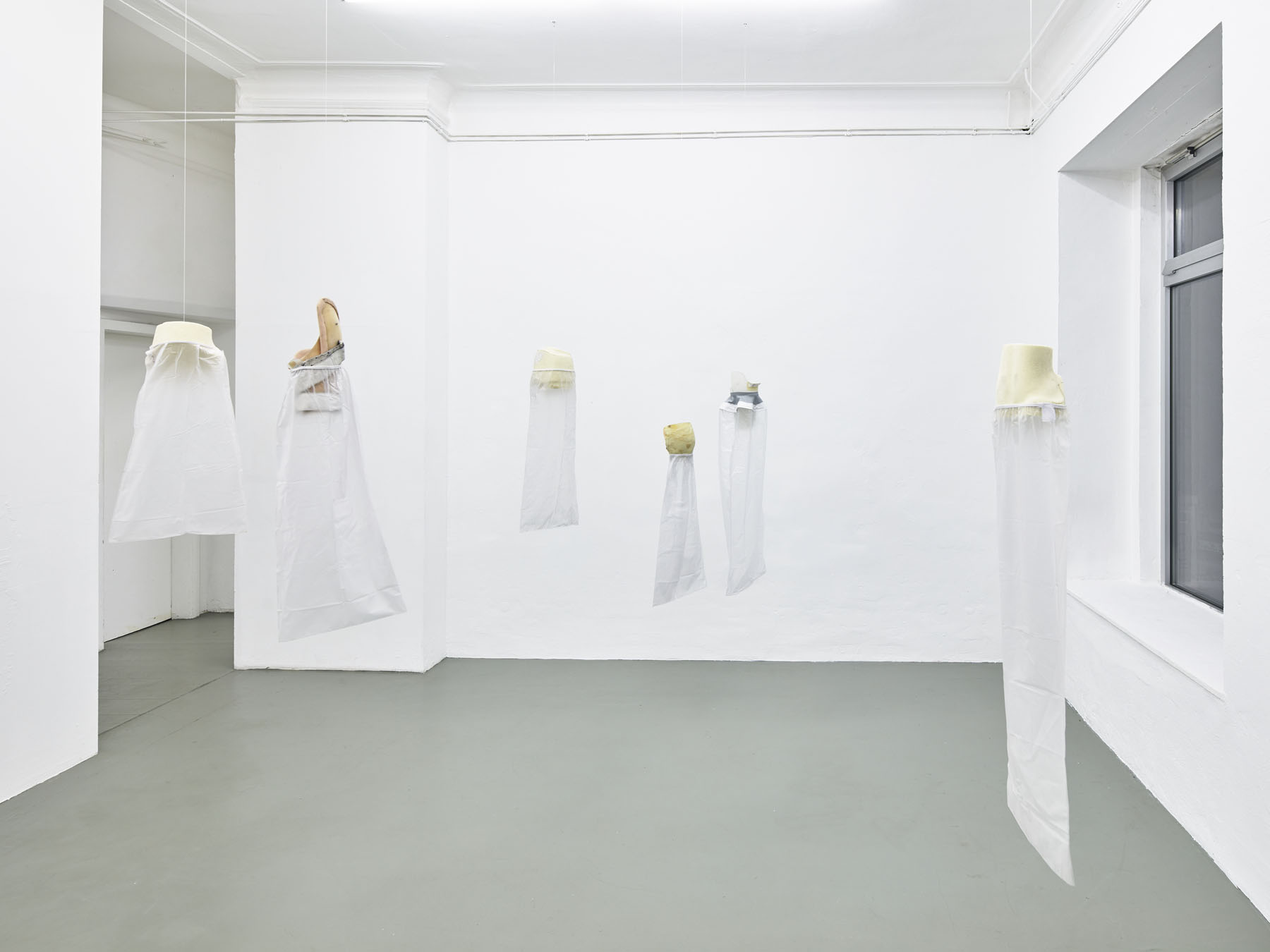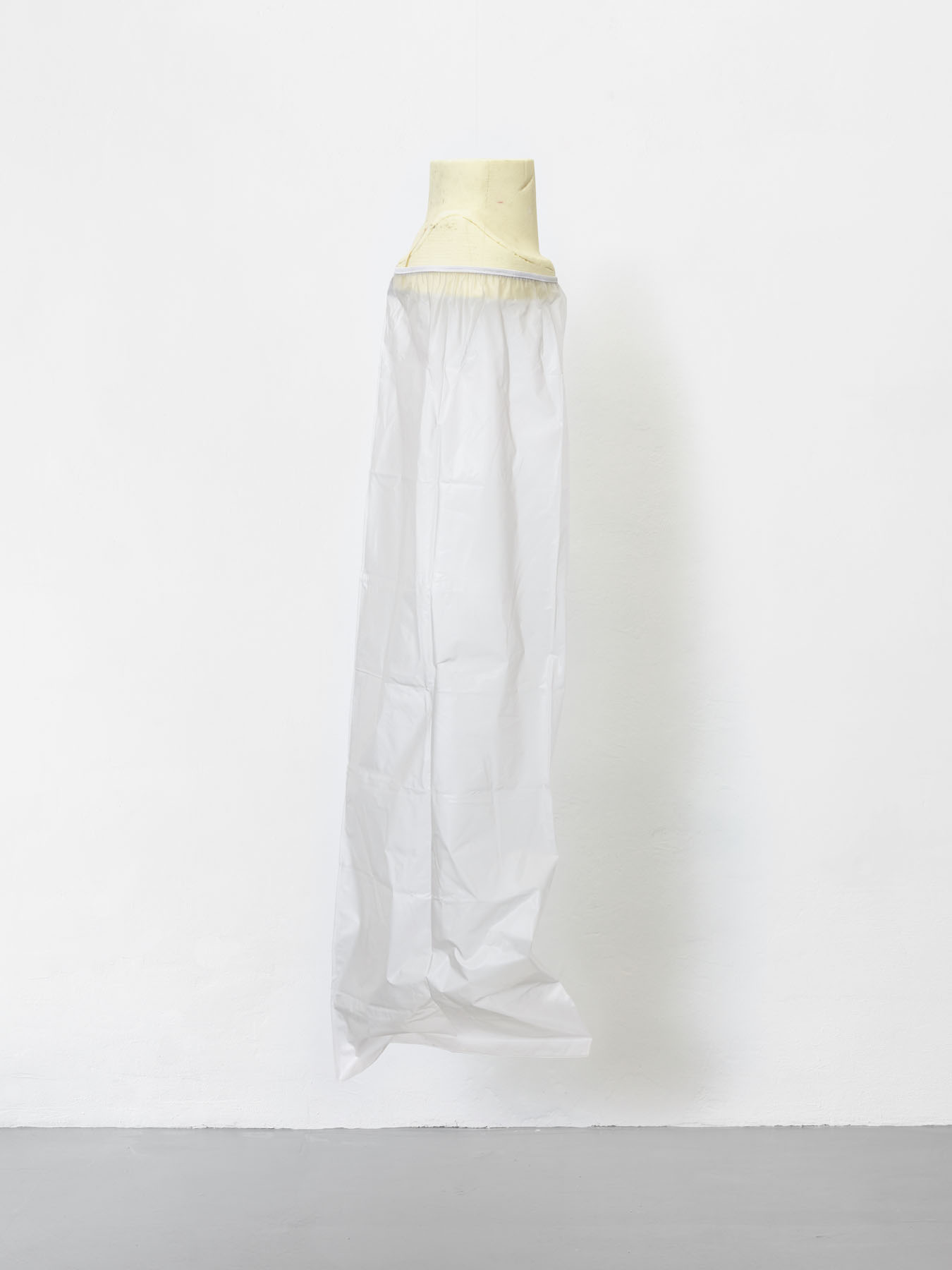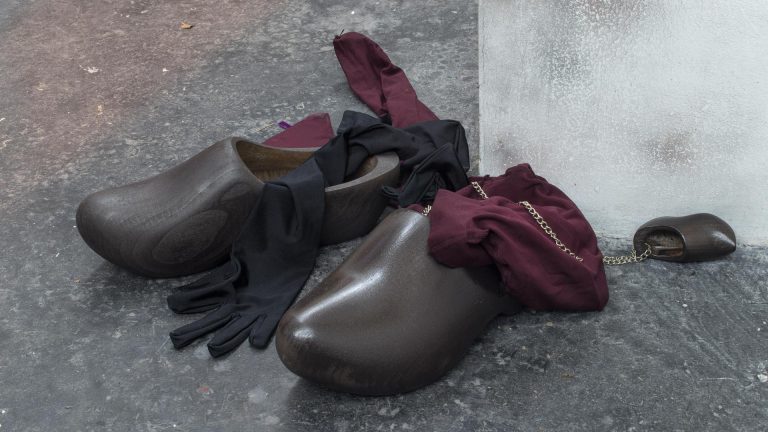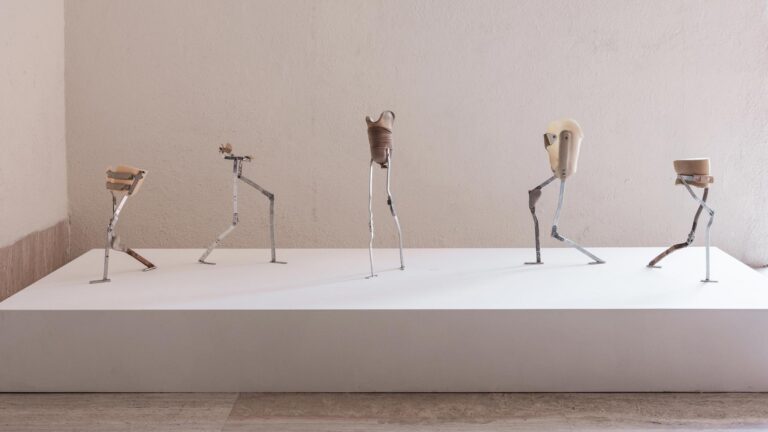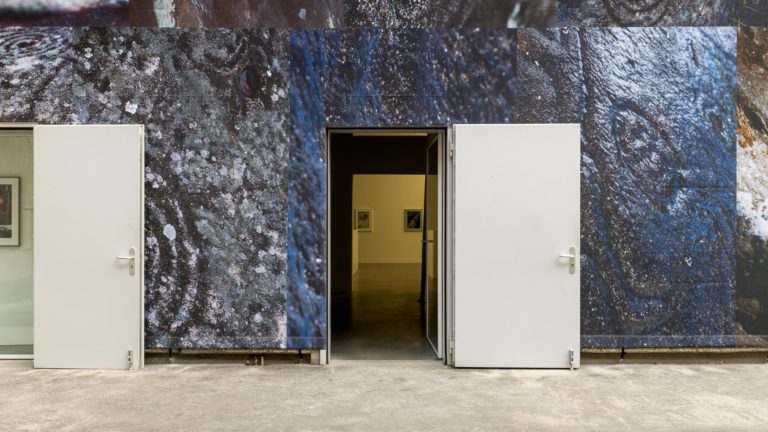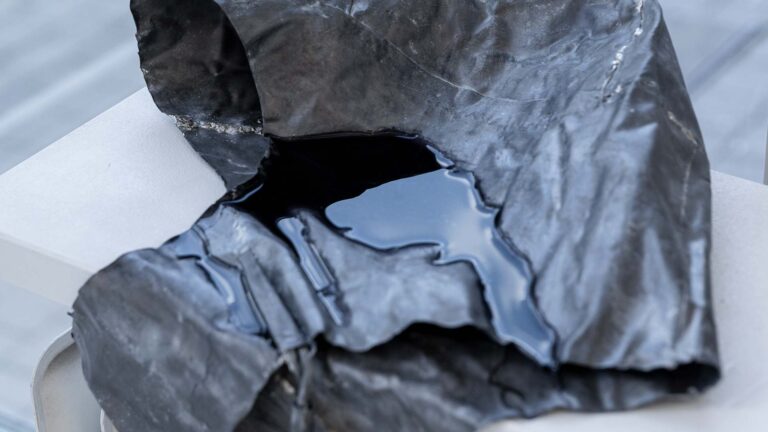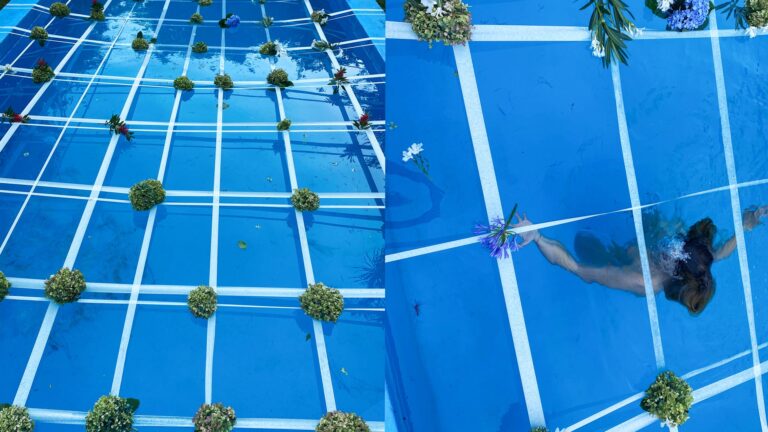Artist: Berenice Olmedo
Exhibition title: CsO, haecceidad
Venue: Jan Kaps, Cologne, Germany
Date: September 4 – November 7, 2020
Photography: all images copyright and courtesy of the artist and Jan Kaps, Cologne
Upon entering CsO, haecceidad, Berenice Olmedo’s new exhibition at Jan Kaps, one is first greeted by an installation occupying the majority of the floor of the main gallery space. It is made up of pneumatic splints, an archaic orthopedic device still in use in Mexico or India, for instance. These ”boots” inflate in a disordered way through an air pump system initially intended to inflate or deflate hospital mattresses, which themselves are support systems for immobilized bodies. Once again emerges here the dichotomy around the function of “walking”, which could already be found in Olga (2018), presented in a previous exhibition at the gallery[1]. The boots also have a martial side, and one begins to think about what would happen if these plastic boots / feet would find autonomy, and could free themselves of their plastic tubery, to possibly ”walk”. Olmedo’s body of work also references “mechatronics“, a kind of art which started in the sixties as a dialectic between the human and the technological body, questioning the crescent hybridization of biological and artificial lives.
A second body of work consists of assembled forms of polyurethane sculpted from human body parts, often limb stumps, to create a prosthesis for the said missing limb. Depending on the prosthetic makers in Mexico City, these shapes are either made by hand or by scanning the limb and then sculpted using a computer-controlled milling machine. Olmedo reuses these elements, often kept as an archive for the patient, but whose existence bears witness to a process, as protagonists of her sculptures, diverting their initial function to allude to other parts of the body. Here, she uses these shapes as a sort of “neck” to which she attaches plastic collars / skirts originally intended to protect a cast during the washing of the patient. The result are hung like life-size silhouettes from the ceiling, solitary or in small groups, down to the height of the spectator, producing an anthropomorphic feeling that shifts our perception of these body parts, rendering their function illegible.
Another of these series is precisely the assemblage of finished thermoplastic molds of these stumps, with metal elements taken from devices intended, again, to support the limb or the sick body, such as wheelchairs or pulleys. Their dismantled structures emphasize their structural and mechanical aspects, transforming them into metal “bones”, adjusted below the phantom limb which is the plastic structure intended to receive the patient’s stump. Similar in proportions to a head or a leg, these sculptures evoke the versatility of the human body, as well as its overall harmony, the codependence of its elements, in the end all made of the same materials, flesh, muscles, bones, tendons. A final set of works consists of the arrangement of adult and child moulds for prostheses, legs, feet and joints, foam, concrete and plaster, color ranging from the urine yellow of aged polyurethane foam to the dark orange of decaying foam to the dirty gray of concrete feet: these artifacts are an alphabet book of body sculpture as literal as it is dysmorphic, still questioning the idea of the body’s normality, also evoking its own decadence, its becoming matter.
To create this new set of static and animated sculptures, Berenice Olmedo refers to the concept of “Body Without Organs (CsO)” developed by Antonin Artaud and taken up by Deleuze and Guattari in Mille Plateaux[2], in order to make a parallel with the work she creates through the idea of the differently-abled body. The CsO is “an exercise, a set of practices, a biological and political experimentation”[3] which seeks to assert the existence of a consciousness of the body taken separately from the capacity of its organs to perform a specific function. Producing other relationships of power within the body, it criticizes rationality and the Cartesian cogito, proposing another definition of ”consciousness”. However, “the CsO is by no means the opposite of the organs.
Its enemies are not the organs. The enemy is the organism”[4], that is, an organization of organs which assigns them a fixed function meant to preserve a normative functioning of the body. The CsO, rather, proposes in a chaotic spasm to “walk on the head, sing with the sinuses, see with the skin, breathe with the belly”[5]. What interests Olmedo in the concept of CsO, is the possibility of plastically deconstructing this idea of stability of the organism. If we can take the organs separately, or make them lose all constancy, whether in their location or function due to allotropic variations, what remains of the body? Is there a body awareness that exists beyond these individual functions?
To deepen this question, Olmedo uses another notion, that of “haecceity”, resulting from medieval epistemiological models, which affirms “the set of characteristics, material or immaterial, which makes a thing a particular thing. It is its special essence that sets it apart from all the others[6]. ” We can translate this term as close to the idea of individuality or autonomy. Olmedo seeks with this title to express a paradox, that of the mystery of the autonomy of matter in relation to the model of interdependence that constitutes and identifies the fragile and complex machine that is the body.
Deleuze describes “drug addicts, masochists, schizophrenics”[7] as examples of individuals who seek to disrupt this proper functioning of the organs in order to reach different levels of organization capable perhaps of revealing the state of autonomous consciousness suggested by the CsO, but underlines the danger of such practices, thus affirming the CsO as a horizon: if the CsO refers to a state of consciousness of the body which is only accessible during extreme experiments likely to lead the individual to its loss, it then appears as a double of the real, because it does not describe any existing state. “The Body without Organs, we do not arrive there, we cannot arrive there, we never finished accessing it, it is a limit”[8]. What Olmedo proposes is to approach this limit through art. She offers art as a liminal domain, a “portal” where CsO can be detected as a possible emancipation from the relentless rationality that human life signifies. The CsO proposes to consider a possible model of social organization offering more autonomy to the bodies composing it, a radical utopia of emancipation. Departing from her own specific context —Mexican working class customs and biopolitical habits— Olmedo’s practice aims to develop a wider discourse on emancipation through philosophy and aesthetics. Like the CsO, her sculptures should be perceived as structures endowed with their own autonomy when it comes to the modalities of their existence, appearance, and organization, while struggling with the implacable social reality they represent within the privileged space of the art gallery. The “threshold” that is made visible from this confrontation is the one of a human condition that is not just a matter of biological traits common to human species, but rather a regime of political différance [9] aiming to limit the biological existence of disabled and precarious lives to areas of exception, away from dominant political debates. Bearing happily the contradictions of any work of art, the repulsive and yet familiar works of Berenice Olmedo are ultimately an invitation to share vulnerability as the unsurpassable foundation of our humanity.
-Dorothée Dupuis
[1] Anthroprosthetic, an exhibition by Berenice Olmedo at Jan Kaps, Cologne, 2018
[2] Gilles Deleuze et Félix Guettari, Mille Plateaux, 1980, Ed. Minuit, Paris.
[3] Ibid.
[4] Ibid.
[5] Ibid.
[6] Ibid.
[7] Ibid.
[8] Ibid.
[9] See Derrida’s concept of différance https://en.wikipedia.org/wiki/Diff%C3%A9rance
Berenice Olmedo, CsO, haecceidad, 2020, exhibition view, Jan Kaps, Cologne
Berenice Olmedo, CsO, haecceidad, 2020, exhibition view, Jan Kaps, Cologne
Berenice Olmedo, CsO, haecceidad, 2020, exhibition view, Jan Kaps, Cologne
Berenice Olmedo, Alotropía, 2020, Polyurethane molds drilled in Rodin 4D, 17 × 17 × 39 cm (6 3/4 × 6 3/4 × 15 3/8 inches)
Berenice Olmedo, Alotropía, 2020, Polyurethane molds drilled in Rodin 4D, 19 × 12 × 47 cm (7 1/2 × 4 3/4 × 18 1/2 inches)
Berenice Olmedo, Alotropía, 2020, Polyurethane molds drilled in Rodin 4D, 19 × 12 × 34 cm (7 1/2 × 4 3/4 × 13 3/8 inches)
Berenice Olmedo, Alotropía, 2020, Polyurethane molds drilled in Rodin 4D, 15 × 11 × 36 cm (5 7/8 × 4 3/8 × 14 1/8 inches)
Berenice Olmedo, Alotropía, 2020, Polyurethane molds drilled in Rodin 4D, 15 × 12 × 39 cm (5 7/8 × 4 3/4 × 15 3/8 inches)
Berenice Olmedo, CsO, haecceidad, 2020, exhibition view, Jan Kaps, Cologne
Berenice Olmedo, CsO, haecceidad, 2020, exhibition view, Jan Kaps, Cologne
Berenice Olmedo, CsO, 2020, Polyurethane, plaster protectors, fibreglass bandages, 107 × 21 × 19 cm (42 1/8 × 8 1/4 × 7 1/2 inches)
Berenice Olmedo, CsO, 2020, Polyurethane, plaster protectors, fibreglass bandages, 115 × 12 × 9 cm (45 1/4 × 4 3/4 × 3 1/2 inches)
Berenice Olmedo, CsO, 2020, Polyurethane, plaster protectors, fibreglass bandages, 67 × 19 × 13 cm (26 3/8 × 7 1/2 × 5 1/8 inches)
Berenice Olmedo, CsO, 2020, Polyurethane, plaster protectors, fibreglass bandages, 65 × 15 × 12 cm (25 5/8 × 5 7/8 × 4 3/4 inches)
Berenice Olmedo, CsO, 2020, Polyurethane, plaster protectors, fibreglass bandages, 71 × 12 × 11 cm (28 × 4 3/4 × 4 3/8 inches)
Berenice Olmedo, CsO, 2020, Polyurethane, plaster protectors, fibreglass bandages, 89 × 19 × 18 cm (35 × 7 1/2 × 7 1/8 inches)
Berenice Olmedo, CsO, 2020, Polyurethane, plaster protectors, fibreglass bandages, 113 × 15 × 20 cm (44 1/2 × 5 7/8 × 7 7/8 inches)
Berenice Olmedo, CsO, 2020, Polyurethane, plaster protectors, fibreglass bandages, 109 × 22 × 22 cm (42 7/8 × 8 5/8 × 8 5/8 inches)
Berenice Olmedo, Haecceidad, 2020, Pneumatic splints, hoses pumps for alternating pressure mattress and arduinos, Dimensions variable
Berenice Olmedo, Haecceidad, 2020, Pneumatic splints, hoses pumps for alternating pressure mattress and arduinos, Dimensions variable
Berenice Olmedo, Haecceidad, 2020, Pneumatic splints, hoses pumps for alternating pressure mattress and arduinos, Dimensions variable
Berenice Olmedo, Haecceidad, 2020, Pneumatic splints, hoses pumps for alternating pressure mattress and arduinos, Dimensions variable
Berenice Olmedo, Haecceidad, 2020, Pneumatic splints, hoses pumps for alternating pressure mattress and arduinos, Dimensions variable
Berenice Olmedo, Haecceidad, 2020, Pneumatic splints, hoses pumps for alternating pressure mattress and arduinos, Dimensions variable











